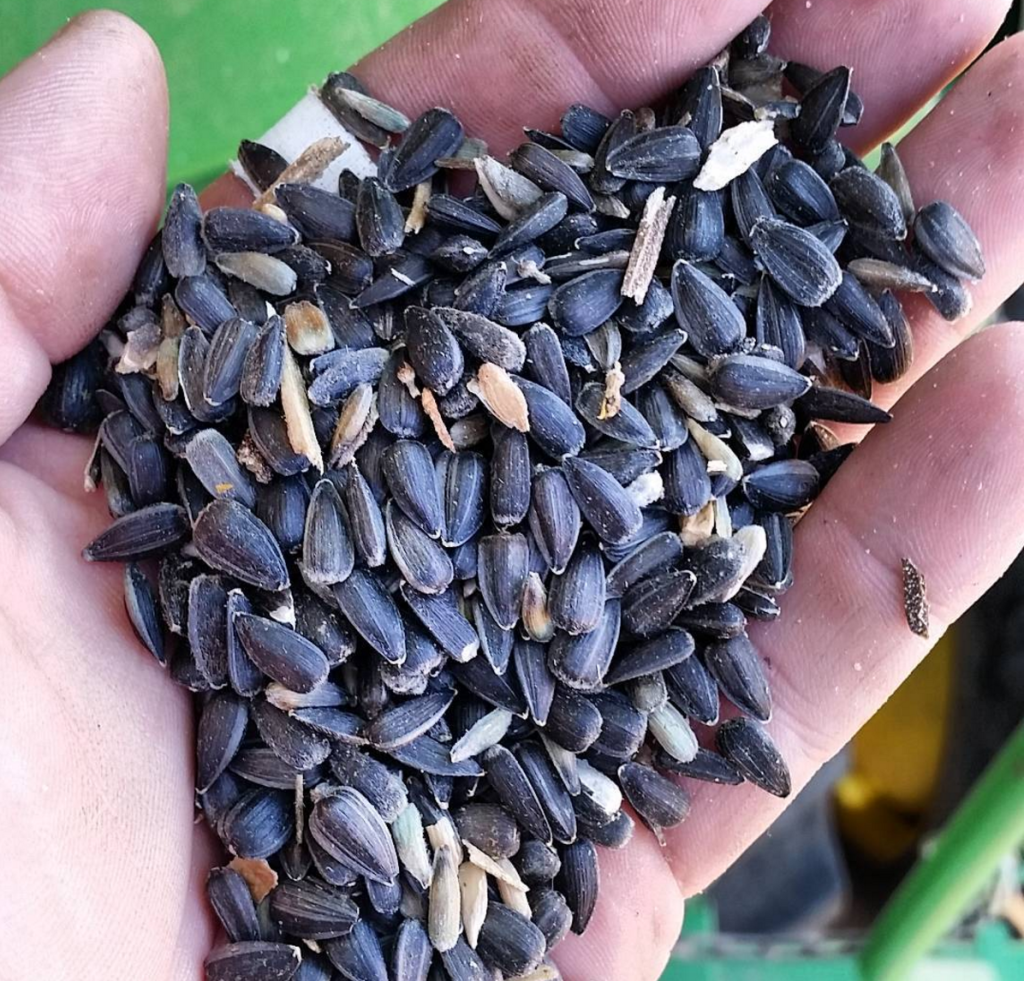
The number one question we get asked about sunflowers is how do you harvest them?
So how do you harvest sunflowers?
It is hard to believe that our sunflowers go from looking like this in August:
To this by late October:
Harvesting Sunflowers
We harvest sunflowers with a combine (harvester) that has a specialty sunflower header attached to it. This header we have retrofitted with modified lifters that attach onto the snouts. This helps pick up any sunflowers that may have fallen down as well as help guide them into the header, as you can see in the photo below it works well. You can also use a pan header or all crop header to harvest flowers.
As with all harvest on our farm, the sunflowers go from the combine into a grain cart which transports them to the end of the field where they go into a semi. The semi will transport the sunflower seeds to a bin on our farm where they will wait until they make the journey towards either the birdseed market or crushed for oil.
The sunflowers we grow are an oil-based crop and fine fibers (dust) from sunflower seeds pose a constant fire hazard during harvest. Fires during sunflower harvest can be extremely common, especially during dry years with low humidity. During harvest, we have to take steps to ensure that the combine is free of dust by blowing it off daily (sometimes more than 1x a day) as well as keeping a water tank in the field in case of a fire. SDSU has actually researched and developed a cover for certain parts of the combine to help deter harvest fires from starting.
Pre-Harvest Application
Much like our wheat, we can apply what is called a pre-harvest application of glyphosate to our sunflowers under a post-harvest weed control labeled use. The added benefit is that glyphosate works the same way on our sunflowers as it does weeds, which in turn results in a faster plant drydown and earlier harvest. For sunflowers, the label requires this pre-harvest application “when the backsides of sunflower heads are yellow and seed moisture content is less than 35%.” The maximum labeled rate for sunflowers is 22 ounces per acre (43,560 square feet) with a minimum interval of seven days between application and harvest. Typically this application occurs via an aerial applicator.
As with wheat, sunflower growers in any state can apply a pre-harvest application, climate dictates that most of this practice occurs in the Dakotas and Minnesota. Cooler temperatures and wet conditions often slow the natural desiccation process in northern areas. Poor weather can cause a decline in crop yield and quality as well as exposing the sunflowers to blackbird pressures, disease, lodging (sunflowers falling down), and other threats.
For additional information on the safety and usage of glyphosate, please refer to this post.
We harvest sunflowers after they have physiologically mature and begin to dry out, also after any pre-harvest intervals. Sunflowers are physiologically mature when the back of the flower head is yellow and are ready to harvest when the head turns brown. Ideal seed moisture for harvest is around 10% or less.
Harvested Sunflower Seed Uses
As discussed in an earlier post, the seeds we grow can go to two different uses that depends on the year and market. First, the seeds can go towards birdseed or they can be crushed for oil. In both instances, we contract transportation for our seeds so they are picked up from our farm in a semi truck and trailer and usually travel east towards Fargo. If our sunflower seeds are for oil, they will end up at ADM in Enderlin outside Fargo to be crushed.
We grow NuSun varieties on our farm. NuSun is a specific type of oil known as a mid-oleic oil. NuSun oil is most notably used in Frito-Lay’s Sun Chips. NuSun oil is lower in saturated fat than other sunflower oils and it doesn’t need hydrogenation which eliminates trans fat. Besides NuSun oil, there are two other types of sunflower oil available: linoleic and high oleic. All sunflower oils are touted for their light taste, frying performance, and health benefits compared to other oils.
Sunflower oil can be found in a variety of products from food to beauty products. In the food industry, often times sunflower oil is used as a frying oil. In cosmetic applications, sunflower oil is used as an emollient or moisturizer. One of my favorite lip balms, Burts Bees, contains sunflower oil.
To see out our combine in action harvesting sunflowers, check out the video below!
To learn more about sunflower production in North Dakota, you can check out these posts:
Resources
Dewey Rohrich, J. (2014). The Truth About Toxic Wheat.
National Sunflower Association. (2008). The PreHarvest Glyphosate Option.






Love this! I’m amazed at the machinery that takes all these crops out! I would love to ride in the combine and watch this all happen! Thank you for informing me how this is all done — didn’t even think about a fire hazard! Happy Harvest to you all!
How cool. I have never seen sunflowers being harvested. Question: do you get docked if the seed has come out of the shell? Thanks for sharing.
Author
For oil or birdseed there is no penalty!
I always wondered! Thanks for answering questions I didn’t even know to ask. 🙂
I LOVED learning about this from you last week! This post is awesome!